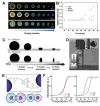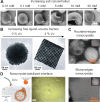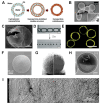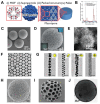Emergent Properties from Three-Dimensional Assemblies of (Nano)particles in Confined Spaces
- PMID: 39044735
- PMCID: PMC11261636
- DOI: 10.1021/acs.cgd.4c00260
Emergent Properties from Three-Dimensional Assemblies of (Nano)particles in Confined Spaces
Abstract
The assembly of (nano)particles into compact hierarchical structures yields emergent properties not found in the individual constituents. The formation of these structures relies on a profound knowledge of the nanoscale interactions between (nano)particles, which are often designed by researchers aided by computational studies. These interactions have an effect when the (nano)particles are brought into close proximity, yet relying only on diffusion to reach these closer distances may be inefficient. Recently, physical confinement has emerged as an efficient methodology to increase the volume fraction of (nano)particles, rapidly accelerating the time scale of assembly. Specifically, the high surface area of droplets of one immiscible fluid into another facilitates the controlled removal of the dispersed phase, resulting in spherical, often ordered, (nano)particle assemblies. In this review, we discuss the design strategies, computational approaches, and assembly methods for (nano)particles in confined spaces and the emergent properties therein, such as trigger-directed assembly, lasing behavior, and structural photonic color. Finally, we provide a brief outlook on the current challenges, both experimental and computational, and farther afield application possibilities.
© 2024 The Authors. Published by American Chemical Society.
Conflict of interest statement
The authors declare no competing financial interest.
Figures








References
-
- Yang Y.; Xiao J.; Xia Y.; Xi X.; Li T.; Yang D.; Dong A. Assembly of CoFe2O4 Nanocrystals into Superparticles with Tunable Porosities for Use as Anode Materials for Lithium-Ion Batteries. ACS Applied Nano Materials 2022, 5, 9698–9705. 10.1021/acsanm.2c01929. - DOI
Publication types
LinkOut - more resources
Full Text Sources
